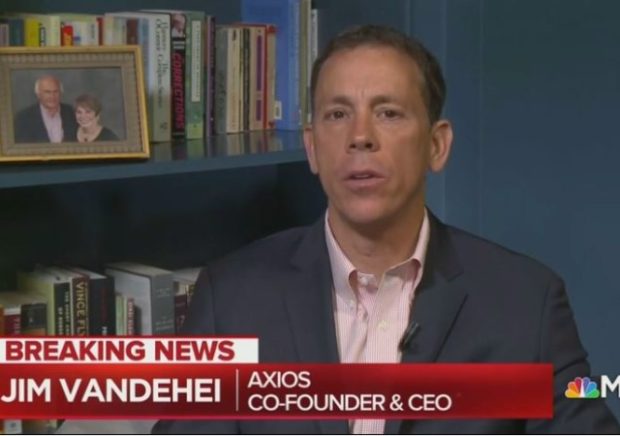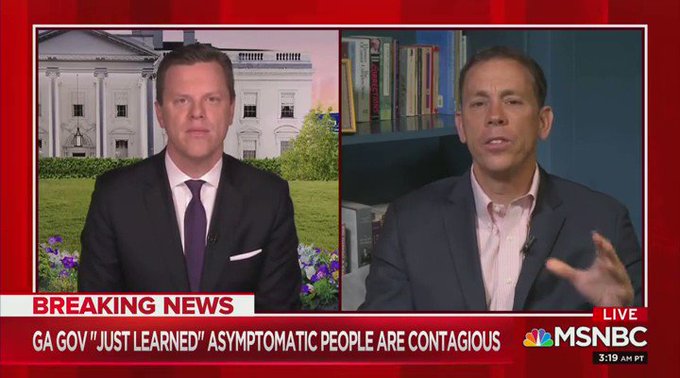False Media Narrative of Red State Negligence In Wuhan Virus Response
The hardest hit states so far are blue states. So why is the media spending disproportionate amounts of time attacking red states?

The MSM have been in full-court press mode for the last two weeks in accusing President Trump, Fox News, and conservative media outlets of downplaying the Wuhan coronavirus until it was too late to contain it.
But another related talking point has emerged in recent days which involves the press relentlessly bashing red states for their allegedly slow response in comparison to blue states. In a nutshell, the reason they have supposedly been slower to put restrictions in place is that they are taking their cues from Trump, Fox, and Rush.
Axios CEO and co-founder Jim VandeHei is a notable example of a media figure who employed this strategy, and he did so in an interview last week on MSNBC’s “Morning Joe” program. Here’s what he said:
What you’re seeing here, and this is a bigger problem for society, is information inequality,’ VandeHei said. ‘Like, why (did) Desantis do what he did? Why did Georgia wait so long? They were listening to President Trump. They were watching Fox News and listening to Rush Limbaugh. The information was there. In the information bubble, they were basically getting a lot of sort of noise and news pollution.
Watch:
Axios’ @JimVandeHei: Red states were slow to respond to the Coronavirus because “They were listening to President Trump, they were watching Fox News and listening to Rush Limbo [sic]”
1,117 people are talking about this
In another instance of the media bashing red state governors, MSNBC’s Stephanie Ruhle brought on Sen. Marco Rubio (R-FL) Friday to talk about Florida’s response to the pandemic. She practically pleaded with Rubio to criticize Republican Gov. Ron DeSantis for what she insinuated was a needless delay in implementing shelter in place orders for his state.
Rubio didn’t take the bait, and instead alerted her to the fact that most counties in the state already had restrictions in place prior to DeSantis’ decision to put shelter in place orders in effect:
“Can we talk about your state of Florida? One of the last states — not all the states have participated, one of the most recent to issue this stay-at-home order,” Ruhle said. “What in the world is going on down there? You have a whole lot of senior citizens and last I checked, they’re pretty high risk.”“Yeah, so let me say one thing. I think for all practical purposes, we were in a stay-at-home order. Virtually every county in the state, if not every, had restrictions in place. Perhaps with the exception of,” Rubio replied, before Ruhle cut him off.“Senator come on now. You and I — Stop it.”“No I’m serious, it’s true!” Rubio insisted.
Not only is Rubio right about Florida, but the same can be said as well for the remaining red state governors who have not mandated shelter in place orders. Cities and counties in those states have put restrictions in place and so have their governors to varying degrees, though in the latter case their measures have not been as drastic as the ones taken in states like California.
I’m in North Carolina, where Gov. Roy Cooper (D) implemented shelter in place a couple of weeks ago after numerous counties had already done so. But in South Carolina, Gov. Henry McMaster (R) has effectively done the “stay at home” thing by pretty much shutting down all “non-essential” services. He’s done everything but make the actual declaration. So it’s more than a little dishonest for the mainstream media to assume red states that haven’t gone the shelter in place route haven’t taken other measures to contain the outbreak.
The media should consider, too, that not every state’s situation is the same, so naturally their responses are not going to mirror each other. For example, the drastic measures put in place in states like New York wouldn’t necessarily be a good fit for the midwestern states that have seen far less cases, and that’s even accounting for the disparities in testing, as Pro Publica’s Alec MacGillis explained:
I'm getting responses of "it's bad everywhere, it's just not being tested, it's being covered up." On what evidence? If you doubt data, use most basic metric: hospitals not being overwhelmed as in NY, Detroit, etc. Bottom line: most are being spared the hell they are going thru.
80 people are talking about this
To date, the hardest hit states are not red states. They’re blue states: New York, New Jersey, Michigan, and California. That’s not to say that red states aren’t going to see steep increases in their curves in the coming weeks. Some models predict some of them will.
But if the media were really interested in being informative instead of using the crisis to make Republican governors out to be the bad guys, they’d spend more time reporting on how New York leaders were slow to respond to the crisis, with NYC Mayor de Blasio and other local and state Democratic officials downplaying the Wuhan Coronavirus threat in February and early March.
They’d also devote more attention to how the Democratic governors of Nevada and Michigan acted to ban the use of the chloroquine and hydroxychloroquine to treat the virus before reversing course after widespread outcry.
But their actions don’t fit the media’s narratives, so instead the media disingenuously focuses on Republican governors and conservative media types.
Polling guru Nate Silver even took issue with those who were pitting red states against blue states when talking about response times:
People sure like to post things about how there are huge disparities between red states and blue states in social distancing... when if you look a the actual numbers the differences aren't actually that big and may largely be explained by other variables (e.g. urbanization).
556 people are talking about this
It's almost like people who live in an area with 1/100th the population density may be able to get by with less strict measures.
See binge tweeter's other Tweets
If what the government is saying is correct, the country still has several more weeks to go before the worst of this is over. So it remains to be seen where the next hot spots will be after New York City has reached its peak. In the meantime, instead of disproportionately attacking red states, the mainstream media should do the following things:
1) Critical analyses of where things went wrong early on in blue state hot spots.
2) Acknowledge that a “one size fits all” model for how states should be responding to the outbreak doesn’t really work, because each state’s situation is different.
2) Acknowledge that a “one size fits all” model for how states should be responding to the outbreak doesn’t really work, because each state’s situation is different.
— Stacey Matthews has also written under the pseudonym “Sister Toldjah” and can be reached via Twitter. —







No comments:
Post a Comment